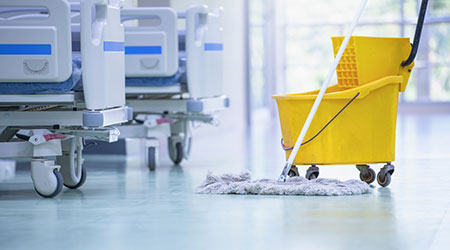The safety of patients, healthcare providers, and staff is top priority for hospitals, assisted living facilities, nursing homes, clinics, and other healthcare facilities. But an ongoing shortage of facilities and housekeeping workers is making this essential task more difficult for healthcare facilities across the country. In October 2019, the National Conference of State Legislatures reported a 3.6% unemployment rate, continuing a near a five-decade low. While this is good news for job seekers, it puts significant pressure on organizations struggling to meet their operational demands.
Technology can help close the labor gap, and it can also lower costs and increase efficiency by helping healthcare organizations’ facilities and housekeeping departments do more with less. One example is the TASKI Intellibot. This autonomous system thoroughly cleans floors leaving facilities staff free to perform other cleaning and maintenance tasks nearby. Not only do the intellibots clean effectively and efficiently, they’re also designed to reduce water, chemical, and energy consumption, which saves money and helps healthcare facilities move towards their sustainability goals.
The prevention of healthcare-acquired infections is another key piece of the healthcare safety equation. This is another area where technology can make a significant difference. Fighting the bacteria and pathogens that cause infections means ensuring that all surfaces are thoroughly disinfected and sanitized frequently, even areas that are hard to reach like the undersides and backs of surfaces.
Electrostatic atomizers that deliver a mist immediately surrounding and enveloping all intended target areas like the Clorox Total 360 and Protexus cordless are more effective in their germ kill rate. They more thoroughly disinfect and sanitize all surfaces, especially ones that are hard to reach and out of the line of sight and may be missed when staff uses traditional cleaning methods. These systems use an electrode to add an attractive electric charge to the cleaning solution, which causes the charged solution to better reach and uniformly coat all surfaces. The charged particles also clear the air more quickly than those disbursed by other delivery systems, which means people can safely return to the room more quickly.
Compared to another technology commonly used to sanitize healthcare facilities, bacteria-killing UV systems, electrostatic sprayers allow staff to clean and turn around rooms more quickly. The UV system takes 20 minutes to treat the room and needs to be repositioned several times during the process. The UV technology can also only kill the bacteria it “sees” or can reach with its light. But because electrostatic sprayers envelope surfaces with the cleaning solution, they kill more germs more effectively, including the common and dangerous C. difficile bacteria and methicillin-resistant Staphylococcus aureus (MRSA).
To keep floors in healthcare facilities clean and sanitary, they need to be stripped and recoated frequently. Many finishes require long dry time intervals, which takes the room out of service for an extended period. In addition, the ingredients in some finishes have a strong odor, adding to the amount of time the room can’t be occupied. The SC Johnson Professional® Floor Stripper does not contain butyl or ammonia so there’s no strong odor. Their finish also dries quickly so rooms do not have to be taken out of use for an extended period, which is important in busy healthcare facilities, and it can be used on most types of flooring, including vinyl composite, vinyl asbestos, 100% sheet vinyl, terrazzo, rubber, granite, brick, and slate.
Safety in healthcare facilities goes well beyond cleaning and infection control. Lighted exit signs help keep patients and staff safe in the event of a fire or power outage. Maintaining these signs, however, can be time-consuming, putting strain on an already overloaded facilities staff. In long-term care facilities, for example, regulations require that every lighted exit sign be checked every month and each 30-second test must be noted in the record. These inspections require a significant number of labor hours that could be better spent on other projects.
Lumaware’s photoluminescent exit signs are an alternative to electric signs and offer a number of benefits. Verified by the Joint Commission to meet the standards for the Center for Medicare and Medicaid (CMS), the signs charge themselves using a small amount of ambient light, so they don’t require batteries, light bulbs, electricity, or testing. Not only does this save labor, it also cuts costs and makes this type of sign a greener alternative to electric exit signs.
By making technology part of the facilities and housekeeping strategy, all types of healthcare facilities can keep patients and staff safer, lower expenses, and get the work that needs to be completed done even in the face of shortages of employees to fill facilities and housekeeping positions.
Steve Attman is Co-CEO of ACME Paper & Supply Company.

 UF Health Hospitals Rely on Green Globes to Realize Their Full Potential
UF Health Hospitals Rely on Green Globes to Realize Their Full Potential How Healthcare Facilities Can Be Truly Disaster-Resilient
How Healthcare Facilities Can Be Truly Disaster-Resilient TriasMD Breaks Ground on DISC Surgery Center for San Fernando Valley
TriasMD Breaks Ground on DISC Surgery Center for San Fernando Valley Bigfork Valley Hospital Falls Victim to Data Breach
Bigfork Valley Hospital Falls Victim to Data Breach AI-Driven Facilities: Strategic Planning and Cost Management
AI-Driven Facilities: Strategic Planning and Cost Management